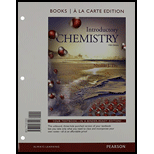
Concept explainers
Interpretation:
Each of the given compounds is to be classified as ionic or molecular. Whether the metal forms one type of ion or more than one type of ion is to be determined in case of an ionic compound.
Concept Introduction:
The ionic compound consists of the metal and non-metal. Metal donate their electrons to the non-metal and become cationic, and non-metal accept the electron from the metal and become anionic. Ionic compound forms the ionic bond between the metal and non-metal. It is separatedtheir charges on dissociation.
The molecular compound consists only non-metals. There is no separation of charges in a molecular compound on dissociations. Molecular compounds form a covalent bond between two non-metals.
Want to see the full answer?
Check out a sample textbook solution
Chapter 5 Solutions
Introductory Chemistry, Books a la Carte Edition & Modified MasteringChemistry with Pearson eText -- ValuePack Access Card -- for Introductory Chemistry Package
- What is the name given to this compound, MnclO7arrow_forwardTetracarbon dioxide is an unstable oxide of carbon with thefollowing molecular structure:What are the molecular and empirical formulas of thissubstance? (a) C2O2, CO2 (b) C4O, CO (c) CO2, CO2(d) C4O2, C2O (e) C2O, CO2arrow_forwardDetermine whether the metal in each ionic compound forms only one type of ion or more than one type of ion and name the compound accordingly.1) BaO2)SrI23)PbCl44)FeI3arrow_forward
- 1. Which of these ranks the metals from most reactive to least reactive?arrow_forwardIs Cl2 a atom, molecule or a compoundarrow_forwardA 67.2 g sample of gold and palladium allo contains 3.40x10^23 atoms. What is the mass percentage of the gold in the alloy. And what is the mass percentage of the palladium in the alloy? Do not give handwriting solution.arrow_forward
- Calculate the mass of vanadium(V) oxide (V2O5) that contains a trillion (1.00*10^12) vanadium atoms.arrow_forwardA metal compound ‘X’ reacts with dil. H2SO4 to produce effervescence, The gas evolved extinguishes a burning candle. If one of the compound formed is calcium sulphate, then what is ‘X’ and the gas evolved? Also, write a balanced chemical equation for the reaction which occurredarrow_forwardA metal ion with 2+ charge has 23 electrons and forms a compound with a halogen ion that contains 17 protons. (3)arrow_forward
 Chemistry: Principles and PracticeChemistryISBN:9780534420123Author:Daniel L. Reger, Scott R. Goode, David W. Ball, Edward MercerPublisher:Cengage Learning
Chemistry: Principles and PracticeChemistryISBN:9780534420123Author:Daniel L. Reger, Scott R. Goode, David W. Ball, Edward MercerPublisher:Cengage Learning Chemistry for Engineering StudentsChemistryISBN:9781337398909Author:Lawrence S. Brown, Tom HolmePublisher:Cengage Learning
Chemistry for Engineering StudentsChemistryISBN:9781337398909Author:Lawrence S. Brown, Tom HolmePublisher:Cengage Learning World of Chemistry, 3rd editionChemistryISBN:9781133109655Author:Steven S. Zumdahl, Susan L. Zumdahl, Donald J. DeCostePublisher:Brooks / Cole / Cengage Learning
World of Chemistry, 3rd editionChemistryISBN:9781133109655Author:Steven S. Zumdahl, Susan L. Zumdahl, Donald J. DeCostePublisher:Brooks / Cole / Cengage Learning Introductory Chemistry: A FoundationChemistryISBN:9781337399425Author:Steven S. Zumdahl, Donald J. DeCostePublisher:Cengage Learning
Introductory Chemistry: A FoundationChemistryISBN:9781337399425Author:Steven S. Zumdahl, Donald J. DeCostePublisher:Cengage Learning Introduction to General, Organic and BiochemistryChemistryISBN:9781285869759Author:Frederick A. Bettelheim, William H. Brown, Mary K. Campbell, Shawn O. Farrell, Omar TorresPublisher:Cengage Learning
Introduction to General, Organic and BiochemistryChemistryISBN:9781285869759Author:Frederick A. Bettelheim, William H. Brown, Mary K. Campbell, Shawn O. Farrell, Omar TorresPublisher:Cengage Learning




